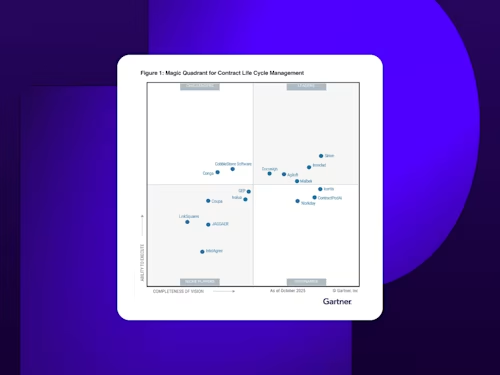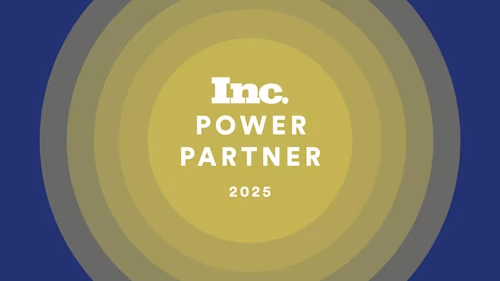
Q&A: How to Streamline Government Contract Management with AI
Docusign’s Steve Wright draws on his experience at the GSA to offer insights about how AI and automation can streamline government contract management, reduce risk, and improve efficiency throughout the contracting lifecycle.

As leaders look for ways to improve government contracting, artificial intelligence (AI) is stepping into the spotlight. From accelerating decision-making to unlocking unprecedented levels of transparency and efficiency, AI is reshaping the federal procurement process and setting the stage for a smarter, more streamlined government.
In the following Q&A, Steve Wright, Head of Public Sector Channels and Alliances at Docusign, draws on his experience at the General Services Administration (GSA) and shares his perspective on the biggest contract management challenges agencies face today. He also discusses how AI and automation can help simplify processes, reduce risk, and improve performance throughout the contracting lifecycle.
The following has been edited for length and clarity.
Can you share a bit about your background and your role at GSA?
I worked for about 11 years at GSA, doing a variety of procurement and compliance work across different types of contracts, from simple micro-purchases and acquisitions under the simplified acquisition threshold to larger, more complex procurements under Federal Acquisition Regulation (FAR) Part 15. That included negotiated procurements, source selection teams, and more. So, a little bit of everything.
During my last year at GSA, I served as the product owner for the Acquisition Gateway, which is a resource for federal buyers. It provides access to templates, market research tools, and other materials required under the FAR to help ensure compliance when negotiating and awarding government contracts.
How was technology integrated into your day-to-day work at GSA?
At the time, contract writing and compliance systems were all over the place. The contracting tools and processes could vary completely depending on the agency or office. There wasn’t just one platform—it was usually a mix, with information scattered across different systems.
For example, representations and certifications might be downloaded as PDFs from one site, then manually added to a contract file or purchase request. Based on my experience, there’s a real opportunity to streamline and better connect these tools to make procurement more efficient and user-friendly across the board.
What were some of the biggest challenges you experienced with contract management systems and tools?
One of the biggest challenges I experienced was the reliance on outdated and disconnected technology. Federal procurement follows strict rules, but when systems aren’t aligned, everything becomes slower and more manual.
Take Procurement Administrative Lead Time (PALT) as an example. Manual routing, like emailing PDFs for approvals, causes delays and reduces visibility into where things stand.
Contract construction is another issue. Sections L and M define how proposals are submitted and evaluated, and if they’re unclear or inconsistent with the FAR, it can lead to protests, delays, and added costs.
Agencies need systems that improve visibility and build confidence to help contracting professionals avoid errors, reduce risk, and foster trust on both sides of the process.
It sounds like those manual processes and legacy systems impacted efficiency. Can you share more about that?
One hundred percent. That’s the key. Anyone in government contracting would probably agree that inefficiency is one of the biggest themes—not because people aren't working hard, but because the systems and processes haven't kept up with the complexity of the mission. There are so many different forms to fill out, boxes to check, and signatures to collect, and they’re often scattered across multiple platforms. You might have 56 different tasks to complete, all stored in different systems, each with its own login and workflow.
It’s not that the tasks themselves are unnecessary—many of them exist for good reasons, like ensuring compliance, transparency, or accountability. But the way they're executed can create unnecessary friction. Instead of helping people do their jobs better, the tools often add to the workload. If we can streamline those steps with smarter systems—ones that integrate, auto-populate, or guide users through the process—we’d free up contracting officers to focus more on strategy, vendor engagement, and getting the best outcomes for their agencies.
There’s a lot of buzz right now around AI and contracts in government. What’s your take on the conversation?
At a high level, focusing on procurement use cases for AI makes a lot of sense. The greatest potential lies in targeting manual, time-consuming processes and augmenting the work of acquisition professionals. One compelling opportunity is in the creation of solicitations. AI can help determine what documents are needed based on the type and size of the procurement, such as which elements of sections L and M apply, or if the evaluation method should be the lowest price or best value. It could pull from millions of past procurements to recommend the right structure.
Clauses are another area. Many are included by default, even when they aren’t needed. AI could flag irrelevant ones, saving time and reducing confusion. Post-award, AI can surface key elements tied to performance and compliance and help agencies and vendors track what matters without digging through every document.
What are some of the misconceptions or concerns you’ve seen in discussions around AI and government contract management?
One common misconception is that AI will take over the whole process and remove the need for human involvement. But at the end of the day, the contracting officer still makes the final award decision. It’s not a hands-off situation.
Another concern is that AI could introduce errors or increase the risk of protests. But in reality, I think the opposite is true. When used thoughtfully, AI can help reduce mistakes, especially in the repetitive, administrative parts of the process. Think about all the manual steps: copying data, checking boxes, routing forms. Those are ripe for automation.
AI isn’t here to replace people, it’s here to support them. Think of it as a smarter toolkit for contracting officers, helping them focus on strategy instead of paperwork.
What excites you most about the future of AI and contract management in government, and how can it help agencies meet their broader strategic priorities, like efficiency and transparency?
What excites me most is how AI can bring real efficiency and visibility to areas that have traditionally been overlooked. Take FOIA requests, for example—being able to instantly locate the right document and track who accessed it is a game-changer for transparency.
Too often, contracts are signed, filed away, and forgotten until there’s an issue. AI changes that by making documents searchable, trackable, and easier to manage.
It also helps with compliance. Think about large businesses managing small business subcontracting plans—hundreds of suppliers, complex reporting, multiple systems. AI can surface what agreements exist, who they’re with, and which obligations require attention.
How do you see AI-powered solutions helping to address these challenges?
A lot of the pain points we’ve discussed—from scattered documents to manual processes—connect directly to what we’re solving with Docusign Intelligent Agreement Management (IAM).
When you think about all the different types of contracts in government—including contracts, subcontracts, NDAs, and teaming agreements—Docusign eSignature is already being used to sign them. Now we’re layering on AI to understand the language in those documents. Our tools help compare agreements, identify key clauses, and surface insights based on past contracts.
On the backend, our intelligent repository, Docusign Navigator, tracks renewals, compliance metrics, and subcontracting plans. Everything is stored in one place, making it easy to respond to things like FOIA requests or protests. AI helps categorize documents and sends automatic reminders for key dates and compliance requirements.
You mentioned automation playing a key role in improving efficiency and compliance. Can you expand a bit more on how automation specifically supports compliance, auditability, and risk mitigation in government contracting?
Great question. Absolutely. In government contracting, compliance and auditability are critical to maintaining trust and transparency. Automation strengthens these areas by embedding compliance directly into workflows—ensuring every approval, signoff, and review is properly routed, recorded, and easily traceable.
Rather than relying on manual processes and memory, automation enforces consistent standards and captures a complete audit trail, minimizing risk and reducing errors. At Docusign, we’re helping agencies take this a step further with IAM, where automation and AI work together to organize, track, and surface agreement insights in real time. For example, Docusign IAM automatically routes agreements to the correct approvers—like contracting officers, legal teams, and policy reviewers—ensuring no critical step is missed. Every action is captured in a secure, tamper-evident audit trail, including timestamps, IP addresses, and signatory details. And once agreements are finalized, they’re seamlessly archived in a centralized repository, and Docusign Iris makes it easy to search, track, and retrieve records for audits or compliance reporting.
There is no need to dig through emails or worry about missing approvals. It’s all documented and easily accessible.
What advice would you give to government agencies looking to modernize their contracting processes?
Start with the basics. Where are your contracts stored? Are they consolidated and easy to search? Is access controlled so that only the right people can view or edit them? These are foundational questions that many teams struggle with.
Next, look at all of your routing and approval processes. How many signatures are required? Are the forms up to date and used consistently? This is where automation and AI can really streamline things.
Finally, think about risk mitigation. If you're relying solely on training and standard operating procedures, AI can help ease that burden by guiding users through compliant workflows and flagging what needs attention.
Looking to streamline contract management efforts within your agency? Reach out to sales@docusign.com to get started.
Related posts
Docusign IAM is the agreement platform your business needs




